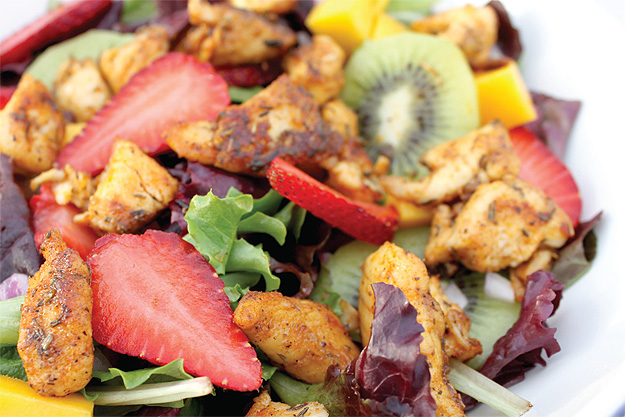
During an afternoon stroll, Yael Kozar gave her two young daughters a taste of a protein bar with peanuts. Her 18-month-old, Ky, spit out the bite; but within an hour, her nose started running and she was grouchy. By 6:30 that evening, her eyelid was swollen shut. She was red and puffy and was wheezing. Kozar rushed her to the hospital.
“She was dying in my car,” Kozar says. Doctors resuscitated Ky, and tests revealed that she was allergic to peanuts and had experienced anaphylaxis, a life-threatening allergic reaction in which the immune system releases a flood of chemicals that drops blood pressure and tightens airways.
Kozar abandoned her career as a television producer to become an advocate and member of the Food Allergy and Anaphylaxis Network. She also hosts the Anaphylactic Allergy Podcast. Food allergy “is not somebody else’s problem,” she explains.
“We kept Ky safe for 5 1/2 years,” Kozar says. But a trip to a restaurant almost killed Ky when she tasted a sauce on her father’s plate that contained peanuts, even though the Kozars had specifically told their server about Ky’s deadly allergy to nuts. He didn’t tell the chef, and it nearly cost Ky, then 7, her life. “She was grabbing at her throat. She had that look of death in her eyes,” Kozar says. Ky ended up in four hospitals with four anaphylactic reactions in three days — from one taste.
The episode scarred her esophagus, which required surgery.
Ky is now an active 12-year-old, but the Kozars must be constantly vigilant. Accidental skin contact, or even inhaling traces of peanuts, such as on an airplane flight, could spark a reaction.
Peanuts top the list of foods that cause anaphylaxis, but allergies can occur with any food, including spices.
“Food allergy isn’t something obscure,” explains Dr. David Waldman, chief of allergy and immunology at Eisenhower Medical Center in Rancho Mirage. “Statistically, it falls into main groups.”
In fact, eight major foods cause 90 percent of allergic reactions: Milk, eggs, peanuts, wheat, fish, shellfish, soy, and tree nuts. Sesame and cantaloupe also are common offenders, Waldman says.
As many as 15 million Americans have some type of food allergy; 6 million of those are children, many of them younger than 3.
Allergies tend to run in families: Having a parent or parents with allergies, asthma, or eczema increases the risk. Most food allergies begin during childhood, but they can show up in adulthood, although the cause isn’t clear. Up to 85 percent of children outgrow food allergies (most commonly eggs, wheat, milk, and soy) by age 10, but allergies can recur later in life. Shellfish, fish, and peanut and tree nut allergies are usually lifelong conditions. There is no cure.
Reactions to food are fairly common, but the majority of those reactions are caused by food intolerance, not allergies. Food allergies and food intolerance are completely distinct conditions with different triggers and reactions, Waldman explains. Food allergies are immune responses that can affect the entire body; intolerance is far less severe, usually hits only the digestive tract, and may be due to an inability to digest a particular food. A common example, affecting about 10 percent of Americans, is when your body fails to digest sugar because you are lactose-intolerant. “This can cause cramps and diarrhea,” Waldman says. “But a food allergy [to milk] has nothing to do with the lactose. It’s the protein in the milk [alpha S1-casein].”
Normally, your body’s immune system will target toxins, bacteria, viruses, or other “invaders.” Allergies occur when your body mounts a response to something that is normally harmless, such as the protein in a food. Your body reacts by creating immunoglobulin E (IgE) antibodies and the powerful chemical histamine to try to expel the offender. According to Waldman, about 20 percent of the population carries extra IgE antibodies. As a result, allergy symptoms occur wherever the histamine is released. It can manifest itself in hives, breathing problems, itchy skin or mouth, stomach cramps, and, in the worst cases, anaphylaxis.
In addition, most people with food allergies have other allergies: pollen, dust, and mold — the presence of which can worsen reactions to food. In the windy desert springtime when pollen counts are elevated, “your body’s histamine levels are already very high,” Waldman says.
“That’s why reactions are so variable and frustrating.”
Certain allergies also cause a cross-reaction with similar substances. For example, apples contain similar allergens to tree pollen; melon is akin to ragweed pollen.
“Food has a profound effect on our bodies,” Waldman says. If you suspect a food allergy, it’s critical to get tested by a board-certified allergy specialist. The doctor will discuss your dietary history and usually conduct skin-prick tests using small droplets of suspected allergens placed on the skin and then “pricked” with a small lancet. The specialist assesses the reaction by how much swelling and redness occur near the sites. A radioallergosorbent test (RAST) is a blood test that determines if the allergen-specific IgE antibody in the blood binds to the allergen added in the lab, signifying a reaction.
Testing for food intolerance is less precise. It’s usually determined through trial and error. Your doctor may suggest keeping a diary to note which foods cause issues. Elimination diets entail cutting all foods you suspect are causing problems until you’re symptom-free and then reintroducing foods one by one. This should be done under a doctor’s care to ensure nutritional needs are met. Although permanently eliminating the off ending foods may be the solution in some cases, certain intolerances can be easily dealt with — for example, by eating only lactose-free dairy products.
For allergy sufferers like Kozar’s daughter, though, it’s a daily battle to seek out the potential dangers lurking in every bite. Knowledge and preparation are key. The family always calls ahead to restaurants before dining out, and Ky carries a lifesaving EpiPen (which injects epinephrine) in case of anaphylaxis.
Tips For Dining Out
People with food allergies must be extra vigilant when it comes to avoiding potentially dangerous foods. Dining out is possible, with caution. The website allergyeats.com offers an online, searchable database of restaurants — including those in the Coachella Valley — and their allergy friendliness. When dining out:
• Review the menu in advance.
• Call ahead with your special order, preferably during the restaurant’s slower times.
• Bring a Food Allergy Restaurant Card (available at www.faiusa.org) or a Chef Card (available at www.foodallergy.org) detailing your food allergies and stating how your food must be cooked to avoid cross-contamination.
• Dine at off-peak hours when restaurants are less busy.
• Tell everyone about your food allergy: the manager, wait staff , and chef.
• Always bring emergency medications, such as EpiPens, and wear medical identification jewelry.
• Ask to be seated far from the kitchen to avoid allergens.
• Sanitize eating surfaces with cleaning wipes.
• Ask exactly what is in the dish you will be eating.
• Order simple dishes and avoid sauces, soups, and marinades.
• Avoid fried food because of cross-contamination.
• Don’t order desserts, which are oft en pre-made.
Avoid:
• Buffets (high risk of contamination from different foods)
• Bakeries (high risk of airborne allergens, particularly wheat)
• Restaurants with pre-made foods (ingredients may be difficult to trace)
• Asian restaurants (for those with nut allergies)
• Seafood restaurants (for fish and shellfish allergies)
Sources: Food Allergy Initiative, www.faiusa.org; Food Allergy and Anaphylaxis Network, www.foodallergy.org; allergyeats.com
Label Alert
Michelle Brandriss’ son was dangerously allergic to nuts. She wanted to label his daycare items to alert those to whom she entrusted his welfare while she was at work. Now she’s making bright, easy-to-read, waterproof labels that can be personalized and placed on everything from sippy cups to clothing and lunchboxes to sporting goods and luggage.
Name Bubbles are printed with nontoxic, eco-friendly ink and are laundry and dishwasher safe (guaranteed to stick from -60 to 220 degrees), and withstand sunblock and bug repellent. No ironing or sewing is required to apply them. Laminated labels are fade-resistant when exposed to most soaps and chemicals. Namebubbles.com
Safe Shopping
The Food Allergen Labeling and Consumer Protection Act of 2004 requires that manufacturers identify the presence of eight major allergens that cause 90 percent of food allergies (below). These ingredients may be listed on labels in one of three ways: as an ingredient, such as “soy”; in parentheses following an ingredient, such as “casein (milk)”; or indicated by “contains [xyz].” Labels are sometimes updated with new ingredients; check them every time you shop.
MILK
EGGS
SOYBEANS (SOYA)
WHEAT
PEANUTS
TREE NUTS
FISH
CRUSTACEAN SHELLFISH
It is also critical to look for words such as “natural flavoring” and “color additives,” especially if you have allergies to other foods (e.g., spices or seeds). When in doubt, call the food manufacturer (phone numbers are often listed on labels) or avoid the product altogether.
It can be daunting to figure out which ingredients are derived from allergens. Take along a list for reference when shopping to be sure. For a comprehensive breakdown of ingredients and derivatives to watch for, visit the Food Allergy Initiative at www.faiusa.org; read the full Food Allergen Labeling and Consumer Protection Act of 2004 at www.fda.gov.
MyFoodFacts, available at www.myfoodfacts.com, is a personalized iPhone application that shoppers can use to scan product bar codes for allergens.
Symptom Checker
FOOD ALLERGY
• Nausea
• Vomiting
• Cramps
• Diarrhea
• Nasal Congestion
• Rash or Hives
• Chest Pain
• Patches of Itchy, Scaly Skin
• Light-headedness or Fainting
• Tingling Mouth
• Swelling of the Lips, Face, Eyes, Tongue, and Throat
• Anaphylaxis (life-threatening breathing trouble and dangerously low blood pressure)
FOOD INTOLERANCE
• Nausea
• Irritability or Nervousness
• Stomach Pain
• Gas, Cramps, or Bloating
• Vomiting
• Heartburn
• Diarrhea
• Headaches
Sources: Mayo Clinic, www.mayoclinic.com; WebMD, www.webmd.com; American Academy of Allergy, Asthma and Immunology, www.aaaai.org.
CARIBBEAN CHICKEN SALAD

Makes four servings
Dairy free, egg free, wheat free, soy free, peanut free, tree nut free, fish free, shellfish free, gluten free
1 lb. boneless chicken breast, cut in half-inch strips
1 T. blackened seasoning salt
5 c. mixed salad greens
1 mango, peeled and sliced
1 kiwi, peeled and sliced
1 /2 c. red onion, chopped
1 c. sliced strawberries
1 c. raspberry vinaigrette
• Place chicken in a sealable plastic bag and add seasoning. Seal bag and shake to coat.
• Heat oil in skillet over medium heat. Cook chicken until no longer pink (about 10 minutes).
• Toss salad greens, fruit, and onion. Top with chicken. Drizzle with dressing and serve.
CHOCOLATE WACKY CAKE
Dairy free, egg free, soy free, peanut free, tree nut free
3 c. flour
1 1⁄2 c. sugar
6 T. cocoa
2 tsp. baking soda
1⁄2 tsp. salt
2⁄3 c. oil
2 T. vinegar
2 tsp. vanilla
2 c. water
• Preheat oven to 350 degrees. Grease and flour a 13×9 pan.
• Sift dry ingredients into a large bowl. Make three indentations in the dry mix. Add oil, vinegar, and vanilla by pouring each one into its own indentation. Pour 2 cups cold water over all and mix with a whisk or hand mixer until batter is smooth (batter will be thin).
• Pour into pan and bake 25-30 minutes or until toothpick comes out clean.
Published with permission from EatAllergyFree.com

